What is tamari Japanese shoyu? Here’s how to use this soy sauce
Tamari, or tamari shoyu, is a type of sauce commonly used in Japanese cuisine. It’s one of the 5 types of Japanese soy sauces known as shoyu.
Shoyu is made by fermenting soybeans and sometimes wheat, using a special fungus known as koji and a brine (moromi).
Compared to other types of soy sauces, tamari is darker and has a strong umami flavor. It also contains little to no wheat.
This classifies it as gluten-free, vegan, and (sometimes) wheat-free. It’s for these reasons that it’s become a favorite for those with dietary restrictions.
Tamari isn’t the same as shoyu though.
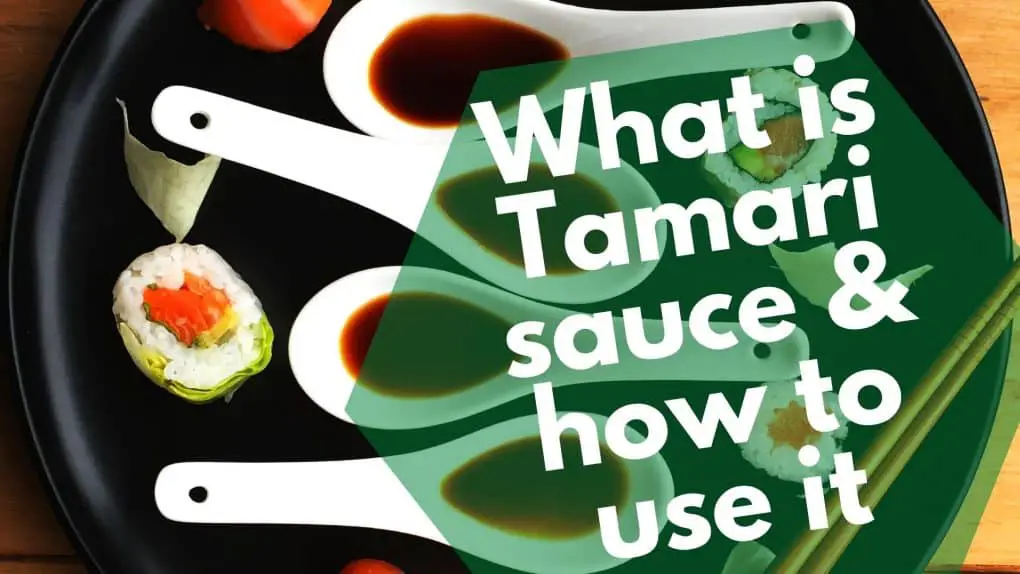
In Japan, “shoyu” is the common term for soy sauce but it takes on 2 different forms: shoyu made from a pulp of soybeans and wheat (the most popular kind), or tamari, which is the liquid content that remains from making miso paste.
Read on to find out more about tamari sauce and how you can use it in your dishes.

Check out our new cookbook
Bitemybun's family recipes with complete meal planner and recipe guide.
Try it out for free with Kindle Unlimited:
Read for freeIn this post we'll cover:
- 1 What is Tamari?
- 2 How to use Tamari
- 3 What is the origin of tamari?
- 4 Where to buy tamari
- 5 How is tamari made?
- 6 Are tamari and soy sauce the same?
- 7 Does tamari have soy?
- 8 Tamari vs. coconut aminos
- 9 Best tamari substitutes
- 10 FAQs around tamari
- 10.1 Is tamari keto?
- 10.2 Does tamari sauce have alcohol?
- 10.3 Is tamari halal?
- 10.4 Is tamari ok for Whole30?
- 10.5 Is tamari soy sauce sweet?
- 10.6 Does tamari have MSG?
- 10.7 Is tamari a probiotic?
- 10.8 Is tamari good for your gut?
- 10.9 Is tamari sauce vegan?
- 10.10 Can I substitute liquid aminos for tamari?
- 10.11 Is tamari sauce healthy?
- 10.12 Can tamari go bad?
- 10.13 Does tamari have to be refrigerated after it’s opened?
- 10.14 Is tamari sauce low fodmap?
- 10.15 Can soy sauce and tamari kill you?
- 10.16 Where is tamari sauce in the grocery store?
- 10.17 Does Walmart sell tamari?
- 10.18 Is tamari sauce the same as tamarind?
- 10.19 Is tamari the same as dark soy sauce?
- 10.20 Does tamari sauce contain yeast?
- 10.21 Why is tamari better than soy sauce?
- 10.22 Is tamari haram?
- 10.23 Is gluten-free soy sauce the same as tamari?
- 10.24 Does tamari have sugar?
- 10.25 Can you eat tamari sauce during pregnancy?
- 11 Conclusion
What is Tamari?
Tamari is a type of soy sauce that is popular in Japanese cuisine. It is made by fermenting soybeans and without wheat using a special fungus known as koji and a brine (moromi).
Tamari is a product similar to soy sauce and even tastes similar, but it originated as a byproduct of miso production.
It is traditionally made with only soybeans (and no wheat), making it more similar in flavor to Chinese-style soy sauce and a great option for gluten-free individuals.
Compared to other types of soy sauce, tamari is darker and has a strong umami flavor. It also contains little to no wheat, making it gluten-free, vegan, and (sometimes) wheat-free.
Tamari is not the same as shoyu, though.
In Japan, “shoyu” is the common term for soy sauce, but there are two different types of shoyu:
- shoyu made from a pulp of soybeans and wheat (the most popular kind)
- tamari, which is the liquid content that remains from making miso paste.
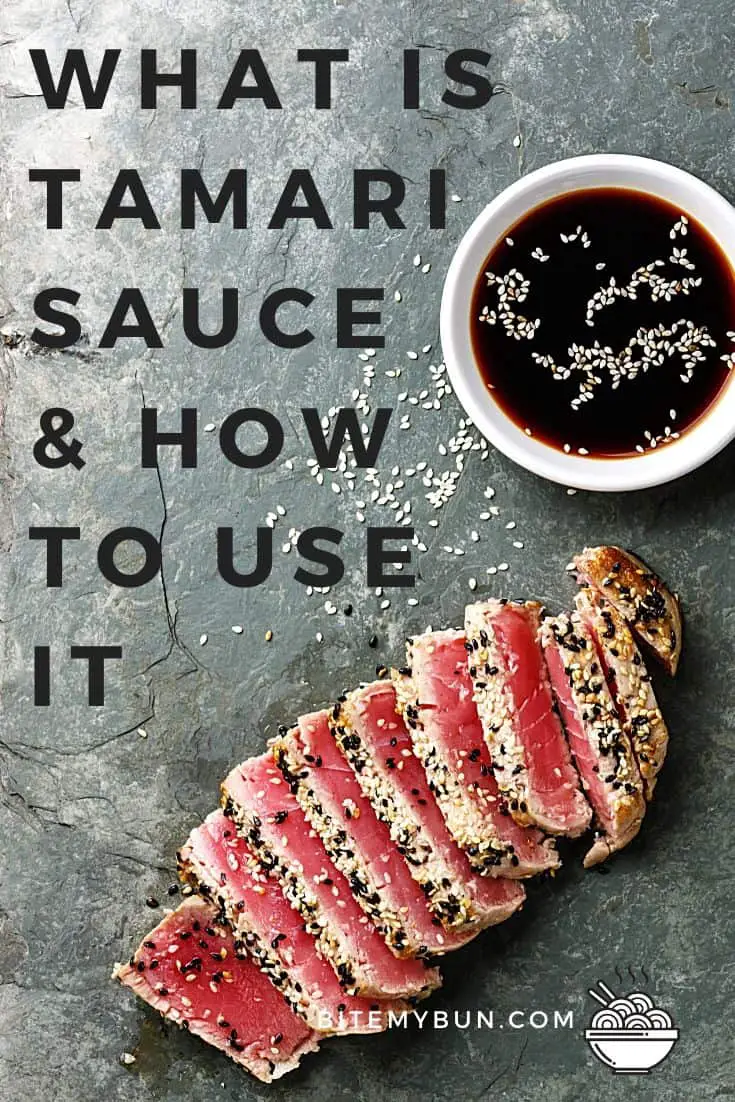
What is tamari sauce made of? List of ingredients
Tamari sauce is traditionally made with:
- soybeans
- water
- salt
- koji (fermented rice & mold)
- a type of alcohol (optional)
Tamari sauce nutrition facts
Tamari’s nutrition facts may differ slightly depending on its manufacturer, but here’s an idea of what you can expect per serving:
- Calories: 10 kcal
- Total fat: 0 g
- Sodium: 980 mg
- Total carbohydrates: 1 g
- Sugars: Less than 1 g
- Protein: 2 g
Also check out these 22 popular sauces to add to your rice
What does Tamari taste like?
Tamari sauce has a dark, rich, and savory flavor with a hint of sweetness. Its taste is similar to soy sauce, but it is not as salty.
Due to its 100 percent soy content, tamari resembles a milder, less salty, and more complex soy sauce.
Unlike tamari, traditional soy sauce contains wheat, which imparts a sharp, almost vinegar-like flavor.
Rather, tamari is loaded with umami, a flavor found in beef, cooked mushrooms, and dried fish, and can be used to impart a meat-like taste to vegetarian and vegan dishes.
Umami is the fifth taste, along with sweet, sour, salty, and bitter. It is a savory taste that is often described as “delicious” or “meaty.”
What does tamari sauce look like?
Tamari sauce is a dark brown color, similar to soy sauce. However, it is not as salty or as transparent as soy sauce.
If there are two bottles (one tamari, the other soy sauce) and they’re side by side, you probably can’t tell the difference.
The texture of tamari is also similar to soy sauce: it’s smooth, slightly viscous, and pours easily.
How to use Tamari
Tamari can be used in any dish where you would use soy sauce. It is especially good in stir-fries, marinades, and dipping sauces.
It can be used as a marinade for meats or vegetables, added to soup or stew, or used as a dipping sauce for sushi if you don’t like soy sauce.
It may also be added to food like tofu, dumplings, noodle, and rice dishes because it adds a nice salty umami flavor.
What is the origin of tamari?
Tamari sauce originated in Japan and was originally a byproduct of miso paste production.
Its history can be traced back to the Heian period (794-1185), when it was first mentioned in a Buddhist scripture.
During this time, soybeans were fermented and used as a meat alternative. The byproduct of this fermentation process was a liquid that we now know as tamari.
Tamari continued to be made in this way for centuries until the Edo period (1603-1868), when new methods of production were developed.
During the Edo period, tamari began to be made with a type of alcohol called shochu, which helped to preserve the sauce and give it a longer shelf life.
This method is still used today.
Where to buy tamari
As Asian cuisine has become more mainstream, it has become easier to find a variety of Asian ingredients, including tamari in Western stores.
You should find tamari in glass bottles (or large plastic jugs in bulk) in the Asian/international section of a well-stocked grocery store near the soy sauce and other Asian sauces.
If it is not available at your local grocery store, try an Asian, international, or health food store, or order it online.

Almost all tamari varieties sold in the United States are gluten-free, though they may contain traces of wheat.
The tamari you locate will likely be labelled as gluten-free, making it suitable for gluten-free diets.
However, Kikkoman brand regular tamari is not gluten-free, though they do produce a gluten-free tamari that is clearly labeled as such.
If you’re looking for tamari sauce that’s tasty and made with ingredients you can count on, here are a few recommendations.
San-J tamari sauce
San-J is known for making tamari that contains 100% soybeans and no wheat. They promise to turn your dishes into flavorful experiences.
Their tamari sauce has an authentic taste and it’s all organic. Theirs is recommended for those on a low-sodium diet.
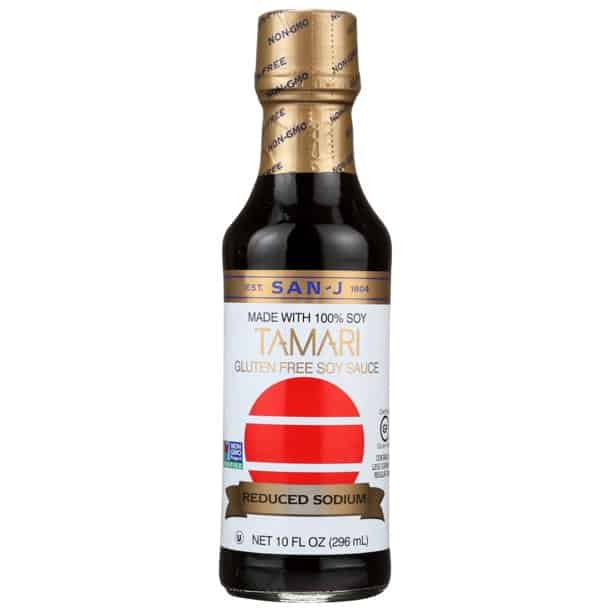
Kikkoman tamari sauce
Kikkoman is a leader in bringing Japanese food products to the United States. When it comes to taste, they’re sure to deliver that umami flavor you’re looking for!
Try theirs to check it out for yourself.
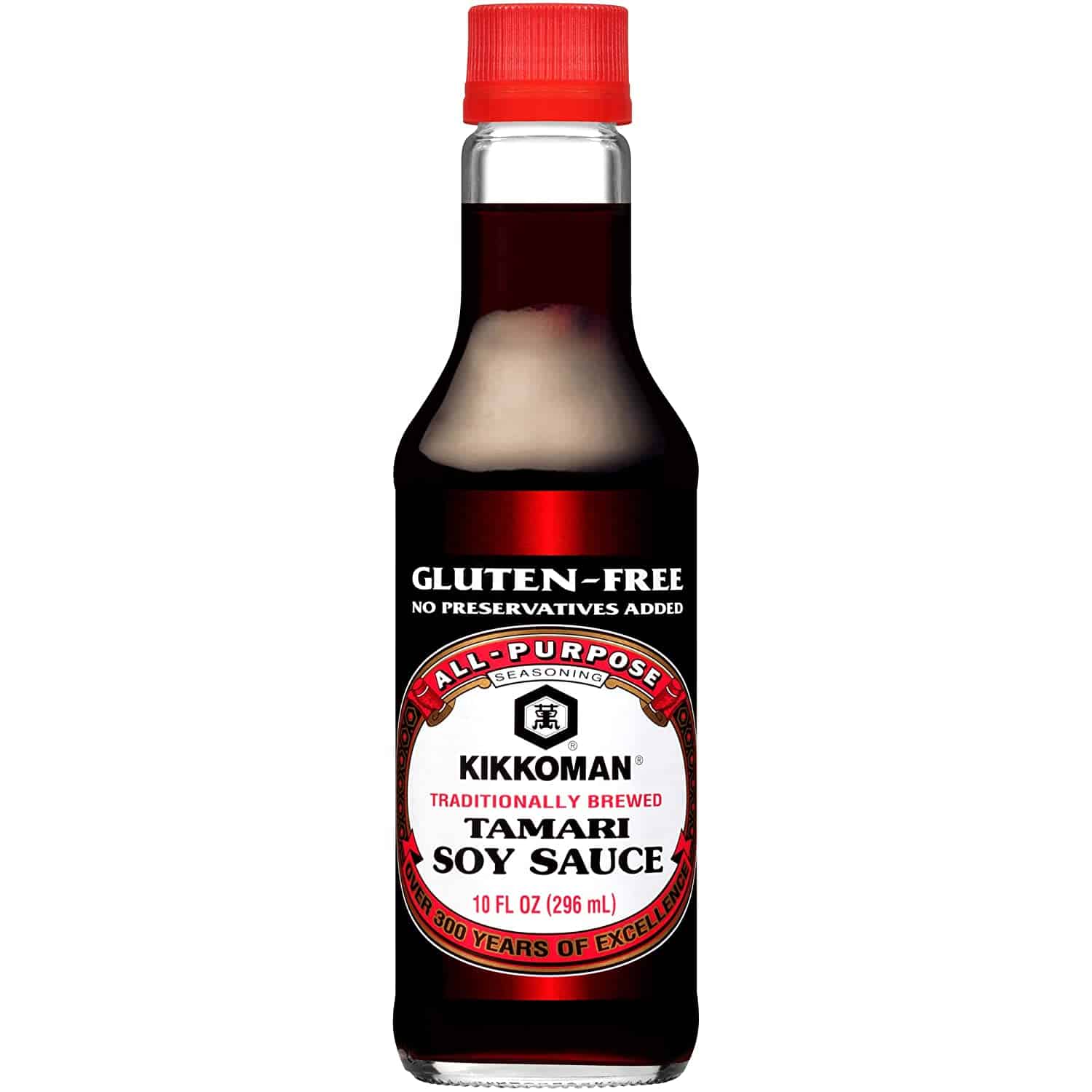
How to store tamari
The best way to store tamari is in a cool, dry place, such as a pantry.
Once opened, it will last for around six months.
You might also wonder if you need to refrigerate tamari? Well, it’s not a must, but it’s recommended.
If you want it to last even longer, transfer it to a glass jar or bottle and store it in the fridge. It will last up to a year this way.
How is tamari made?
Tamari was brought to Japan from China in 7 AD. It’s the result of the fermentation of soybeans.
When soybeans ferment, they produce a tasty, dark red paste that’s known in Japanese cuisine as miso.
During the ripening process, miso produces a protein-rich liquid, called tamari or “that which accumulates”.
Tamari is mainly made in the Chūbu region of Japan.
Are tamari and soy sauce the same?
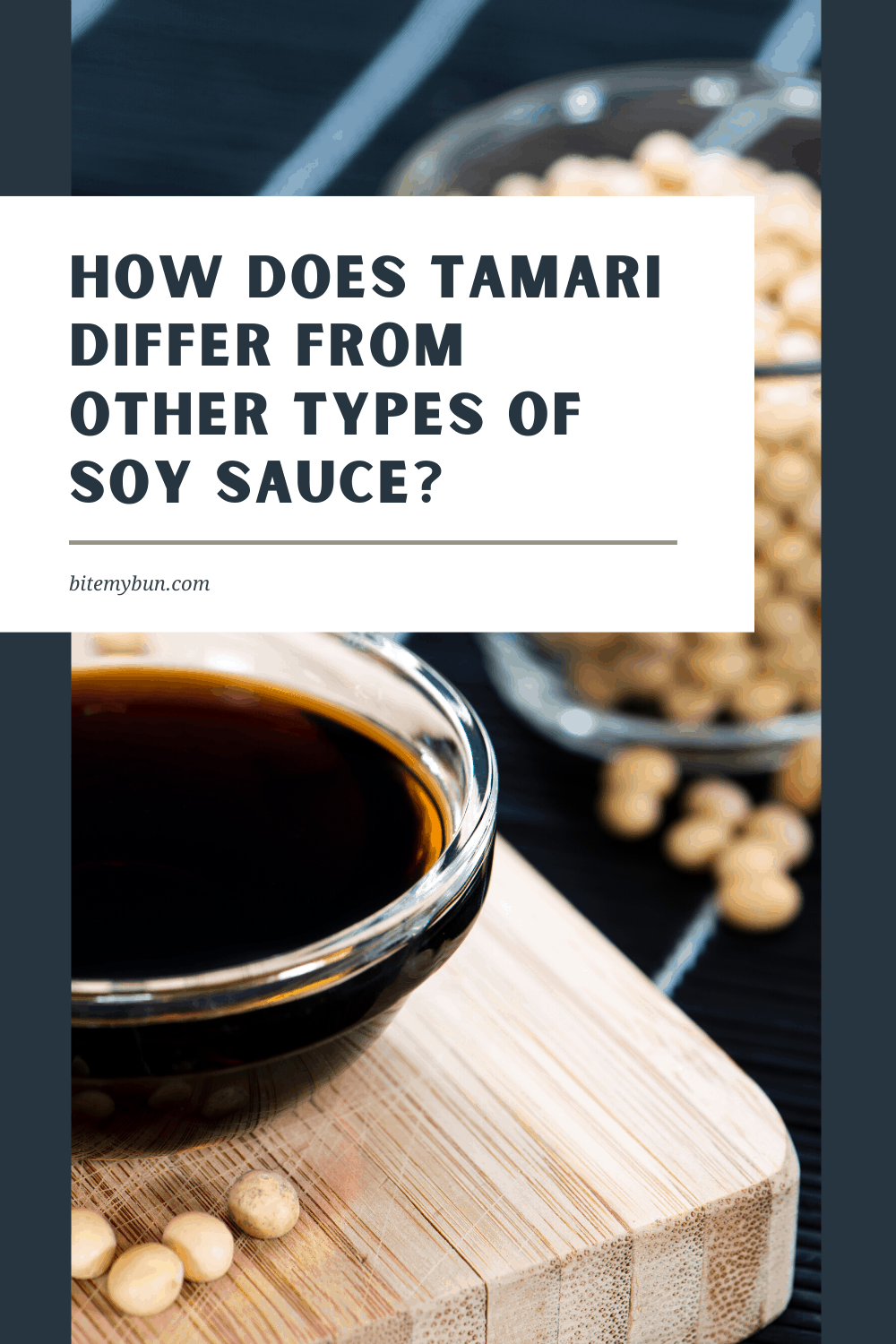
Tamari differs from soy sauce in the way it’s made.
Both tamari and soy sauce are made from fermented soybeans, but soy sauce also contains wheat.
The wheat is added to the soybeans during the fermentation process, which gives soy sauce a sweeter flavor.
Tamari, on the other hand, is made without wheat and has a stronger, more intense flavor.
Traditional soy sauce is made of 4 main ingredients: soybeans, water, salt, and wheat.
The ingredients are fermented for several months using koji and moromi. Then the mixture is pressed to extract its liquid.
Tamari, on the other hand, is a byproduct of miso paste.
It undergoes fermentation and is made of many of the same ingredients: soybeans, water, salt, koji, and moromi. However, little to no wheat is added.
There are also other types of shoyu soy sauces that are popular in Japan, including:
- Koikuchi
- Shiro
- Usukuchi
- Saishikomi
Each differs in its fermentation process, wheat content, thickness, and flavor.
Tamari sticks out for its wheat-free properties, dark color, and strong umami taste.
Umami is a Japanese term for “pleasant, savory taste” and refers to the unique taste of 3 amino acids found in animal proteins.
Does tamari have soy?
Tamari is a type of soy sauce, so it contains soy. In fact, it’s made with 100% soy.
However, it’s worth noting that it’s often made without wheat, which makes it gluten-free and vegan. Therefore, it’s not exactly like soy sauce!
The bottom line is that tamari and soy sauce are both a type of “shoyu,” which is Japanese for soy sauce.
Tamari vs. coconut aminos
Coconut aminos are a soy-free alternative to soy sauce. They’re made using coconut tree sap and salt.
They’re popular with those on paleo and soy-free diets, as they contain less salt than other soybean products.
Coconut aminos are made using a fermentation process, which is why they have a slightly sweeter flavor than soy sauce.
Coconut aminos are good tamari substitutes because they have an umami flavor. However, the flavor isn’t as strong. There’s also a slightly sweeter taste.
The main difference is that coconut aminos are slightly sweeter and less savory than tamari.
When it comes to health, they’re both good choices. They’re both low in calories and carbs.
Coconut aminos also have more vitamins and minerals, as well as amino acids.
Best tamari substitutes
If you don’t have tamari on hand, then coconut aminos and other types of soy sauces will make good substitutes. Here are some other alternatives you can try:
- Coconut aminos are still a very good substitute for tamari sauce
- Fish sauce: Fish sauce is lacking in the rich, caramel flavor tamari offers, but its bright sour taste makes up for it. You can use the same amount of fish sauce as tamari in recipes, but you may end up adding more to make up for the richness.
- Salt: Tamari’s salty taste plays a big role when it comes to how it flavors food. Therefore, salt will make a good substitute, and some even prefer the cleaner taste. Try adding it to sushi or sashimi to find out how it measures up.
- Miso paste: Since tamari is derived from miso, it makes sense that miso paste makes a great substitute for the sauce. Since it’s thicker than tamari, you’ll want to water it down a bit. Try using 1 teaspoon miso paste and 2 teaspoons water to make up for every 1 teaspoon of tamari in your recipes.
- Anchovies: Finely chopped anchovies can make up for that salty, rich tamari flavor. Try it in curries and stir-fries.
- Other soy sauces: This may be stating the obvious, but if you don’t have tamari and you don’t mind the wheat, other soy sauces will be perfectly fine substitutes!
Can I substitute tamari for soy sauce?
As tamari and soy sauce are so alike, you can certainly use soy sauce instead of tamari, even in the same measurements as the recipe calls for.
Just look out for the saltiness of the dish with this alternative, as soy sauce tends to have a lot more salt.
FAQs around tamari
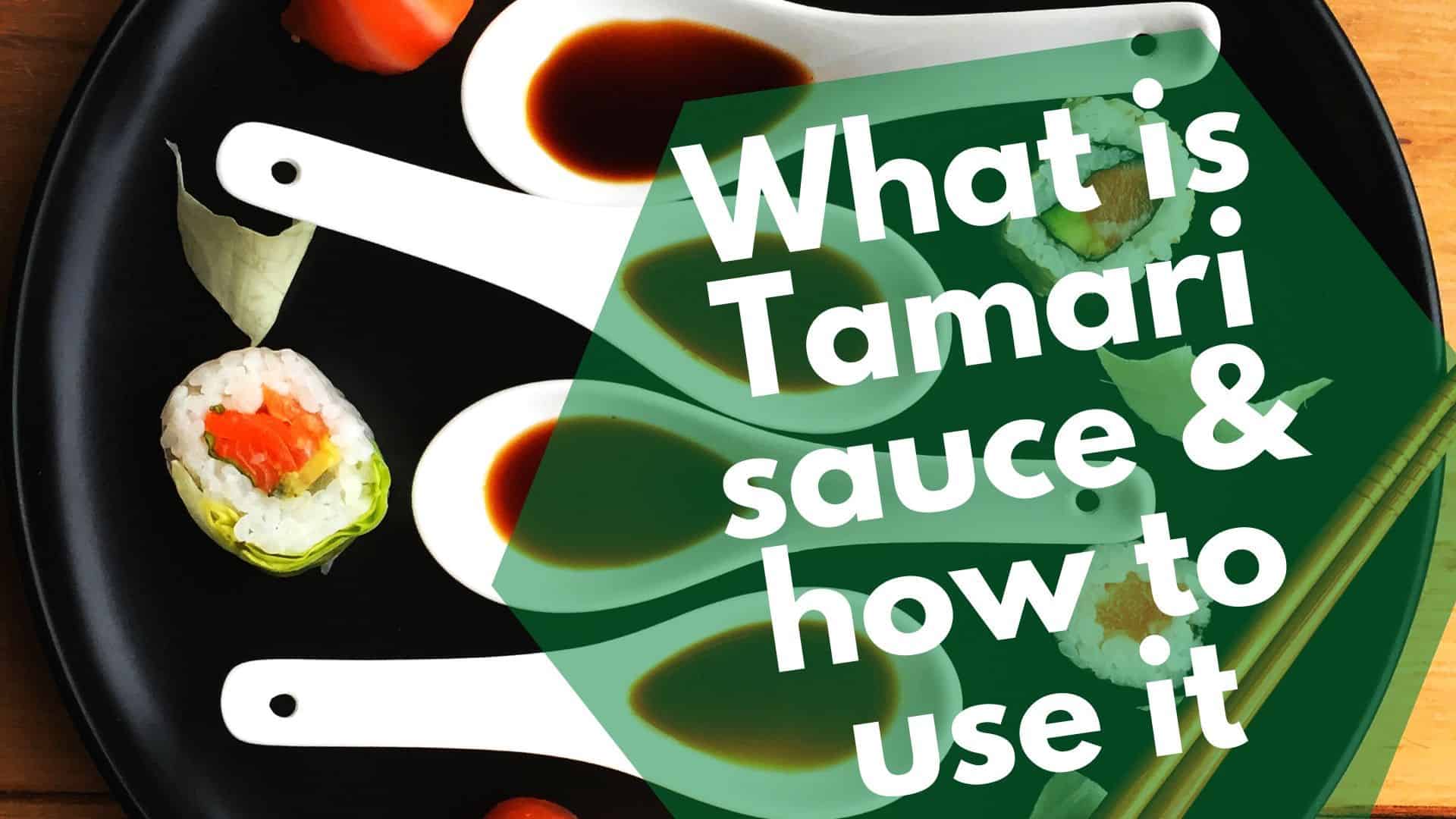
After reading this, you might think you know all you need to know about tamari. But here are a few FAQs that’ll ensure your education is well-rounded.
Is tamari keto?
The keto diet is designed to bring the body into a state of ketosis. This is a state where the body is better able to lose weight and the mind is more focused.
It requires foods that are high in healthy fats and low in carbohydrates.
Soybean products are keto-friendly, as long as they’re non-GMO and fermented. Therefore, tamari is extremely keto-friendly and ready to use as a sauce for your cooking or made into a dressing.
Does tamari sauce have alcohol?
Some tamari sauces do contain alcohol. It’s typically very low, like 2%, which is just enough to prevent yeast and mold growth.
Is tamari halal?
A halal diet consists of foods that Muslims find safe to eat.
A halal diet forbids some meats and it doesn’t contain foods with any ingredients Muslims feel may be harmful to their mental or physical health.
Some forms of tamari may contain traces of alcohol that Muslims aren’t comfortable consuming.
However, this trace amount of alcohol isn’t enough to be addictive, so not all halal dieters will feel uncomfortable adding it to their diets.
In any case, if you’re looking for tamari that you can feel confident is 100% halal, Kikkoman manufactures a sauce you can trust.
Is tamari ok for Whole30?
Whole30 is a diet that emphasizes whole foods and the elimination of legumes, soy, sugar, grains, and dairy.
Therefore, tamari isn’t advisable for those on a Whole30 diet.
Is tamari soy sauce sweet?
Some may think that tamari has somewhat of a sweet flavor due to its caramel taste. However, it’s important not to confuse it with sweet soy sauce.
Sweet soy sauce is another thing, and if you have a recipe that calls for sweet soy sauce, tamari won’t make the best substitute.
Does tamari have MSG?
MSG (monosodium glutamate) is the sodium salt of glutamic acid. It’s naturally occurring in some food products.
It’s also often added to foods as a flavor enhancer and is commonly found in Asian cuisine.
Some think MSG may cause nerve cell damage.
Others may be sensitive to MSG and claim it causes headaches, muscle tightness, tingling, and weakness. However, this has never been proven.
In any case, when eating tamari, you can rest easy. There are many organic brands that make tamari that’s free of MSG and preservatives.
Is tamari a probiotic?
In recent years, tamari has been shown to be a great probiotic-rich sauce. It’s naturally fermented, which means it holds some of these benefits.
It may not have as many benefits from these good bacteria as other foods do, but it can still provide you with enough for the day!
Is tamari good for your gut?
Would you like a healthier alternative to soy sauce? Consider tamari.
Unlike regular soy sauce, which contains wheat and is high in sodium, it’s perfect if you suffer from hypertension or have a wheat intolerance. Plus, it has some probiotic properties as well!
Is tamari sauce vegan?
Yes, tamari is vegetarian as well as vegan! It has no animal byproducts.
Can I substitute liquid aminos for tamari?
Liquid aminos are seasonings that look and taste similar to soy sauce.
However, although the taste is similar, they aren’t exactly the same and they’ll produce a noticeable difference in the flavor of your dishes.
However, if you don’t mind being a bit experimental, you can try them as a substitute.
Is tamari sauce healthy?
Tamari is a healthier alternative to soy sauce as it’s wheat-free. Plus, it contains less sodium than soy sauce. So, if you’re looking for a healthier sauce, tamari is a good choice.
Generally, tamari is relatively healthy. It should be consumed in moderation, but it does have some minor health benefits,
These include vitamin B3, manganese, tryptophan, and minerals, and it is a source of protein and aids in digestion.
Can tamari go bad?
If tamari is unopened, it can stay good for 2 to 3 years, or even more.
To tell if your tamari is still good, take a little taste. If it’s lacking its signature saltiness, this may be a sign that it’s expired.
Does tamari have to be refrigerated after it’s opened?
Yes! Tamari is best if it’s refrigerated after it’s opened however it’s not completely necessary.
Once it’s opened, if it’s kept refrigerated, it’ll be good for about a month for table use and 3 months for cooking use.
Is tamari sauce low fodmap?
Yes, most tamari sauce is low fodmap as it doesn’t contain wheat. However, as with any food, check the label to be sure.
Can soy sauce and tamari kill you?
Yes. One 19-year-old made an unfortunate decision when he was dared by his friends to drink a quart of soy sauce. He almost died of a sodium overdose.
Where is tamari sauce in the grocery store?
If you’re looking for tamari sauce in the grocery store, you’ll most likely find it in the international food aisle. It should be in with other Asian condiments, like hoisin sauce and soy sauce.
If you can’t find it there, you can try searching in the vegan and vegetarian section.
Does Walmart sell tamari?
Yes. Walmart has tamari available for online purchase. It may be in physical stores as well.
Is tamari sauce the same as tamarind?
No. Even though the 2 have similar spellings, tamari sauce and tamarind are completely unrelated.
Tamarind is a tropical fruit with health benefit,s and it’s indigenous to Africa…so not even close.
Tamarind is also used to make sweet and sour sauces, while tamari is more like a soy sauce.
Is tamari the same as dark soy sauce?
Tamari is darker in color than regular soy sauce. However, there’s something called dark soy sauce that’s not the same as tamari.
Dark soy sauce is darker, thicker, and aged longer than regular soy sauce. It also has a slightly less salty taste.
If you have a recipe that calls for dark soy sauce, tamari may make a good substitute, but it won’t produce the exact same flavor.
Does tamari sauce contain yeast?
Because it’s made with little to no wheat, tamari sauce doesn’t contain yeast.
Why is tamari better than soy sauce?
Tamari is a soy sauce made from fermented soy and wheat. Unlike regular-style sauces, it’s typically smoother in texture with less saltiness.
It also usually doesn’t contain preservatives or MSG, making for an additive-free condiment!
Is tamari haram?
Earlier in the article, we discussed whether tamari was halal, referring to whether or not it’s safe for Muslims to eat.
Those following halal diets are also familiar with the term “haram”, which means forbidden. It’s generally used to describe meats that are off-limits.
Therefore, tamari isn’t haram.
Also read: is mirin halal or does it contain alcohol?
Is gluten-free soy sauce the same as tamari?
No. Tamari is the by-product of miso paste. Little wheat, if any, is added to the sauce, making it gluten-free.
Soy sauce, on the other hand, is made from soybeans, water, salt, and wheat.
The wheat can be eliminated, but the process used to make it would still be different from the one used to make tamari. Therefore, they’re 2 different things.
Furthermore, if you look for soy sauce products, you’ll see that both tamari sauce and gluten-free soy sauces are available.
Does tamari have sugar?
The answer to this question is a bit complicated.
Tamari is made through a fermentation process that breaks down the carbohydrates in soybeans into alcohol and lactic acid.
After the fermentation process is complete, the alcohol is usually removed, which leaves behind a slightly sweetened sauce.
So, while tamari doesn’t have cane sugar or other added sweeteners, it does contain a type of sugar called maltose.
Can you eat tamari sauce during pregnancy?
Doctors advise pregnant women not to eat soy sauce while pregnant as it’s high in additives and preservatives.
It’s also high in salt, so you might be wondering if you can substitute soy sauce with tamari sauce.
The good news is, yes! Because this sauce is less salty and has fewer additives and preservatives, you can eat tamari sauce while pregnant.
However, you still want to limit your intake of it, as there’s soy in it still.
Also read: Is It Safe for Pregnant Women to Eat Sushi? Tips & 7 alternatives
Conclusion
Tamari is a great soy sauce alternative that’s ideal for those with dietary restrictions.
It’s also perfect for those who are looking for a healthier soy sauce alternative.
Since it pretty much tastes like tamari, you can dip sushi rolls or marinate your yakiniku meats in it.
Will you be choosing it the next time you’re adding flavor to your dishes?
Next, here are the 6 Best Recipes For Sushi (+ Bonus Methods You’ve Never Tried)
Check out our new cookbook
Bitemybun's family recipes with complete meal planner and recipe guide.
Try it out for free with Kindle Unlimited:
Read for freeJoost Nusselder, the founder of Bite My Bun is a content marketer, dad and loves trying out new food with Japanese food at the heart of his passion, and together with his team he's been creating in-depth blog articles since 2016 to help loyal readers with recipes and cooking tips.
